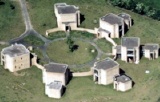2008/09 Warwick EPSRC Symposium on Challenges in Scientific Computing
Mini Symposium on Computational Methods for Geophysical Flows
Organiser: Jason Frank
Friday 3 July 2009
Speakers
Matthias Lauter (Alfred Wegener Institute) A semi-implicit Discontinuous Galerkin Method for non-hydrostatic and hydrostatic atmospheric flows
The vertical structure of the averaged free atmosphere is dominated by the hydrostatic balance. The propagation of waves with horizontal spatial scales larger than 10km is similar in a model based on non-hydrostatic and hydrostatic flow equations. Wave speeds and the dispersion properties of shorter wave lengths differ significantly in for both equation sets.
A non-hydrostatic as well as a hydrostatic equation set is considered in a 2d mesoscale atmospheric model setup. We apply a high order discontinuous Galerkin method with a semi-implicit time stepping on a terrain following quadrilateral grid. Dispersion relations, wave propagation and experimental convergence studies are performed to validate the proposed method with respect to established atmospheric test cases.
Authors: Matthias Laeuter (Alfred Wegener Institute, Germany), Francis X. Giraldo (Naval Postgraduate School, USA), Marco Restelli (Max Plank Institut for Meteorology, Germany), Sebastian Reich (University Potsdam, Germany), Darthe Handorf (Alfred Wegener Institute, Germany), Klaus Dethloff (Alfred Wegener Institute, Germany).
Hilary Weller (Reading) Adaptive Mesh Modelling of the Global Atmosphere
Adaptive meshing of the atmosphere may prove beneficial for resolving tropical cyclones, fronts, convection and orography. However there are a number of challenges before these methods can be effective operationally. These include finding appropriate mesh refinement criteria, automatic re-meshing for unstructured meshes and conservative mesh to mesh mapping which does not alter the partition between balanced and unbalanced fields. I will describe a new model of the global atmosphere which solves the shallow water equations accurately on any mesh of the sphere. This has allowed direct comparisons between different mesh structures and different refinement patterns. I will also describe a new mesh refinement technique which allows infrequent mesh adaptation. This reduces the cost of remeshing and reduces the errors introduced by remeshing.
Matthias Sommer (Berlin) A conservative scheme for the shallow-water system and its statistical and geometrical properties
As is well known, the geometrical description of a dynamical system by means of the (generalised) Hamiltonian representation can be useful for the understanding of its conservative, geometric and statistical properties. In numerics, this method has recently been applied to spatial and temporal discretisations of fluid dynamical systems. Here, it will be shown how such a generalised Hamiltonian / Nambu approach can be used to construct a conservative spatial semi-discretisation of the shallow-water equations on a staggered geodesic grid. Numerical experiments will demonstrate this scheme's capability of representing essential conservation properties of the full (PDE) system and how this affects stability and spectral behaviour. Phase space geometrical and statistical properties of the scheme will also be discussed.
Onno Bokhove (Twente) On the solution of large-scale semidefinite problems in structural optimization
- Luke’s variational principle for potential flow waves has been extended to flows with vertical vorticity. The derivation of this extension will be outlined. The new model combines both shallow water dynamics and classical water wave dynamics.
- Luke’s variational principle for classical water waves has been discretized using a discontinuous Galerkin finite element method.Preliminary numerical results will be presented.
- Extensive tests have been performed for discontinuous Galerkin finite element shallow water models.
- intend to outline a discretization based on the new variational principle, which satisfies the known limiting discretizations introduced above.
- The final aim is to create a fast simulation tool for coastal dynamics with few degrees of freedom in the vertical but including accurate wave dispersion as well as shallow water dynamics.
See also:
Mathematics Research Centre
Mathematical Interdisciplinary Research at Warwick (MIR@W)
Past Events
Past Symposia
Where possible, visitors should obtain an EDUROAM account from their own university to enable internet access whilst at Warwick.
You can register for any of the symposia or workshops online. To see which registrations are currently open and to submit a registration, please click hereLink opens in a new window.
Mathematics Research Centre
Zeeman Building
University of Warwick
Coventry CV4 7AL - UK
E-mail:
MRC@warwick.ac.uk

